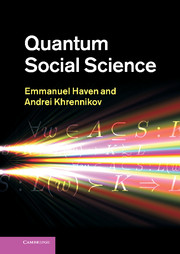Book contents
- Frontmatter
- Dedication
- Contents
- Foreword
- Preface
- Acknowledgements
- List of symbols
- I Physics concepts in social science? A discussion
- II Mathematics and physics preliminaries
- III Quantum probabilistic effects in psychology: basic questions and answers
- IV Other quantum probabilistic effects in economics, finance, and brain sciences
- 10 Financial/economic theory in crisis
- 11 Bohmian mechanics in finance and economics
- 12 The Bohm–Vigier model and path simulation
- 13 Other applications to economic/financial theory
- 14 Neurophysiological sources of quantum-like processing in the brain
- 15 Conclusion
- Glossary of mathematics, physics, and economics/finance terms
- Index
13 - Other applications to economic/financial theory
from IV - Other quantum probabilistic effects in economics, finance, and brain sciences
Published online by Cambridge University Press: 05 July 2013
- Frontmatter
- Dedication
- Contents
- Foreword
- Preface
- Acknowledgements
- List of symbols
- I Physics concepts in social science? A discussion
- II Mathematics and physics preliminaries
- III Quantum probabilistic effects in psychology: basic questions and answers
- IV Other quantum probabilistic effects in economics, finance, and brain sciences
- 10 Financial/economic theory in crisis
- 11 Bohmian mechanics in finance and economics
- 12 The Bohm–Vigier model and path simulation
- 13 Other applications to economic/financial theory
- 14 Neurophysiological sources of quantum-like processing in the brain
- 15 Conclusion
- Glossary of mathematics, physics, and economics/finance terms
- Index
Summary
This chapter attempts to delve deeper into the question on how quantum mechanical techniques can be brought closer into the realm of economics and finance.
The (non-)Hermiticity of finance-based operators?
Hermiticity of operators was discussed in Chapter 4 of the book. We again take up this very important concept in the context of financial asset pricing. It is a classical result from quantum mechanics that the existence of Hermiticity of the Hamiltonian operator is intimately linked with the notion of conservation of probability. The existence of Hermiticity is also known to be closely linked to the concept of spatial localization. Please see below.
Baaquie [1] makes the important argument that the Black-Scholes Hamiltonian is non-Hermitian and this condition provides for the need to satisfy the martingale condition. Please recall that the martingale property was covered in Chapter 2, Section 2.9. It is also important to mention that Luigi Accardi has indicated that it is white noise which may be the cause of non-Hermiticity in a finance context.
One can argue that within an economics/finance context, the equivalent of the state function, using Baaquie [1] [2], can be the option price function. A similar interpretation can also be found in the paper by Li and Zhang [3] (see also Haven [4]). Please note that the work of Li and Zhang is covered in Section 13.12 of this chapter.
- Type
- Chapter
- Information
- Quantum Social Science , pp. 192 - 236Publisher: Cambridge University PressPrint publication year: 2013



